by Michael Pryor
In brief, what we call Steampunk is speculative fiction set in (or redolent of) the Victorian or Edwardian era, taking the mood of these times and applying a Science Fiction or Fantasy approach. It can be set in our world (with hidden secrets) or in an alternative world, the Victorian era not as it was, but as it should have been.
Steampunk isn't historical fiction, even though its sense of period is vital. Steampunk thrills in combining the streetscapes, the social strata and the formality of nineteenth/early twentieth century society with delirious technology-steam driven or not. It often rewrites the events of the period, with real historical personages being dragged into secret plots, bizarre mysteries and-sometimes-outrageously anachronistic hijinks.
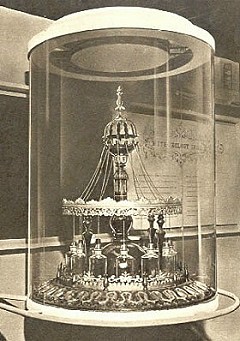
In some ways Steampunk is a nostalgic modern take on the 'Scientific Romances' of Jules Verne, H.G. Wells and other fabulists of this period. Just to set the record straight - Verne and Wells weren't writing Steampunk. Steampunk has a modern sensibility underlying its gaslight setting. It's a retro-recasting, affectionately using some of the ambience of techno-Victoriana but with an approach perhaps put best by the IO9 blog: 'Our love for steampunk is a longing for machines that don't suck.'
Many Victorian readers had a fascination with the astonishing developments in science and technology that were occurring. It was a time of heady optimism, when the future was grand, glorious - and undoubtedly British.
It was a time where Great Exhibitions could draw huge crowds to admire the Tempest Prognosticator (a barometer which used leeches in bottles to predict the weather) and the world's first automatic voting machine. This was the same public that stood in awe in front of the massive sewerage pumping machines when they were opened by the Prince of Wales in 1865, a pinnacle of Victorian achievement and lauded as such by rich and poor alike.
Verne's novels were full of the sense of wonder that marks such imaginings
Of course, these were the sort of people who, as readers, thrilled to depictions of fabulous devices and startling adventures in fiction. Verne's 20,000 Leagues Under the Sea gave the world a brooding genius protagonist and his fabulous submarine. From the Earth to the Moon presented polite gentlemen being shot to the lunar surface via an immense cannon. Verne's novels were full of the sense of wonder that marks such imaginings. Wells' The Time Machine and The War of the Worlds added a cautionary note to imagined technological advances, while his The War in the Air prophetically described the rise of air power in conflicts.

When the Edwardian era passed, this sort of 'scientific romance' faded and its particular combination of plucky optimism and dauntless daring almost disappeared. That is, until a few writers, perhaps sensing something in the air, picked up the baton in the 1970s. This is when Michael Moorcock wrote A Nomad of the Time Streams trilogy set in quasi-Victorian times - The Warlord of the Air, The Land Leviathan and The Steel Tsar - replete with fiendishly advanced airships and gargantuan steam-powered war machines. Soon after, American Harry Harrison produced A Transatlantic Tunnel, Hurrah which the notoriously crusty Auberon Waugh (son of Evelyn) read and 'cried like a baby at the wedding between the beautiful, good Iris and brave Captain Washington'. A thoroughly splendid outcome for all.
To tell the truth, however, these early entries in the Steampunk hall of fame were singular, one offs, reactions against the predominant mainstream of Science Fiction rather than the harbingers of a popular moment.
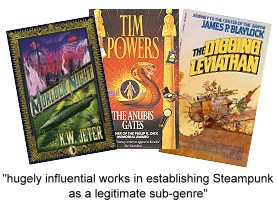
It was only some ten years later that what we call Steampunk truly began. In the early 1980s, a trio of like-minded writers in California formed a loose affinity group, deliberately setting out to write in a mode that would capture some of the feel of Verne and Wells. Good friends K.W. Jeter, James Blaylock and Tim Powers produced Morlock Night (Jeter), The Anubis Gates (Powers) and The Digging Leviathan (Blaylock).
These were hugely influential works in establishing Steampunk as a legitimate sub-genre. And the name? At the time Jeter wrote to Locus, the Science Fiction magazine: 'Personally, I think Victorian fantasies are going to be the next big thing, as long as we can come up with a fitting collective term for Powers, Blaylock and myself. Something based on the appropriate technology of the era; like "steampunks", perhaps...'
Cyberpunk ... (and) ... Steampunk ... were in love with their respective technologies
Remember that this was the time when Cyberpunk had burst onto the scene with the success of William Gibson's Neuromancer, ably aided by Ridley Scott's film Bladerunner. Jeter was nodding in that direction but also acknowledging that Steampunk was partly a rejection of Cyberpunk's computer saturated, gritty near future. In a nutshell, Steampunk went retro-nostalgic rather than indulging in grim extrapolation into a hard-edged and seamy future. Both, however, were in love with their respective technologies: black chrome and computers for Cyberpunk, steam and brass in Steampunk's case. Steampunk however-at least in its early days-was typically more optimistic than the world weary cynicism that was the prevalent tone of Cyberpunk.
Morlock Night (a lunatic sequel to The Time Machine), The Digging Leviathan (subterranean adventures in a hollow earth, complete with merpeople) and The Anubis Gates (a time travel expedition to meet Samuel Taylor Coleridge goes disastrously wrong, with much shapeshifting, Egyptian ritual magic and mad beggar kings) opened the floodgates, especially after Powers' The Anubis Gates won the Phillip K Dick Award in 1984.
This first flowering of Steampunk even swept up William Gibson and Bruce Sterling, two of the heroes of Cyberpunk, and they collaborated on The Difference Engine in 1990-an alternate world where Charles Babbage's steam-powered computer kicks off the information age in Victorian times. Hot on its heels in 1992 was Kim Newman's memorable Anno Dracula (Count Dracula marries Queen Victoria) and in 1995 when Neal Stephenson landed The Diamond Age (the Victorian era never ended, just became grander thanks to nanotechnology helping the British empire endure) Steampunk escaped from its 'of minor interest' cage, attracted attention and began to throw its weight around.
Today's Steampunk is a sprawling, wide-ranging grown-up
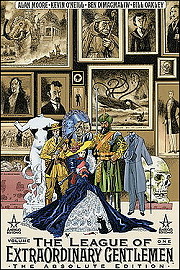
Today, Steampunk has grown up and become a full-on multimedia phenomenon. The spirit of the movement has spilled out into graphic novels, with such splendid forays as Alan Moore's The League of Extraordinary Gentlemen series (Allan Quartermain, Dr Jekyll, Captain Nemo, the Invisible Man and other noteworthies battle nefarious villains) and Five Fists of Science (Mark Twain, Nikola Tesla and Bertha von Suttner unite to save the world from evil industrialists) from writer Matt Fraction and artist Steven Sanders. Part of the appeal of Steampunk lies in the imagined visuals, and the ability of graphic novels to work with these has been important in perpetuating the 'look and feel' of the genre-pith helmets, brass goggles and intricate steam powered machinery abound!
The world of movies has been disappointingly erratic in joining the Steampunk bandwagon, for better and worse. The Wild Wild West (1999) caught some of the visual appeal of Steampunk, and the film of The League of Extraordinary Gentlemen was a triumph of set design and special effects, let down by a muddy script. Katsuhiro Otomo's Steamboy is an anime triumph, and stays true to Steampunk, bringing us a vivid Victorian scenario with glittering science and evil villains-complete with a gigantic floating fortress!
To my mind, the film that is most faithful to the heart of Steampunk is a borderline example. The Prestige (2006) is based on Christopher Priest's 1995 novel and works magnificently as a Steampunk imagining, especially the scenes with the real life maverick scientist Nikola Tesla and his revolutionary electrical experiments.
Today's Steampunk is a sprawling, wide-ranging grown-up which is as likely to include horror, fantasy or romance elements as science fiction. China Mieville's Bas-Lag novels (Perdido Street Station, The Scar and The Iron Council) are called marginal Steampunk by some but are enthusiastically cheered on as central contemporary Steampunk texts by others. In this acclaimed series, dark and gritty steampunk jostles with sordid magic in a world that is both repellent and familiar-and definitely not Victorian London.
Steampunk ... combines the decorum and restraint of a bygone era
Steampunk is greatly marked by a distinctive look and feel. It combines the decorum and restraint of a bygone era with a sense of confidence in a world that is expanding in so many directions-science, technology, social movements and the arts. It is a rich field for writers because characters are working on many, many levels, where subtlety is the key, where manners and morals are understood but changing, where modernity is just around the corner. All of this is set against the most glorious technology, which must look good as well as function well. It's the clanky stuff set against the 'be still my heart' stuff that's such a delight.
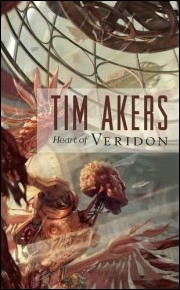
Recent Steampunk books to enjoy? Why not try Tim Akers' Heart of Veridon (a noirish Steampunk thriller with small time criminals caught up in events rather larger than themselves) or The Alchemy of Stone by Ekaterina Sedia (a struggle for power between alchemists and clockwork engineers, told from the viewpoint of an intelligent female clockwork automaton). Or perhaps Stephen Hunt's complex and spiky The Court of the Air (full of grotesquerie, a stratified society in crisis with steam-driven slaves on the point of rebellion) would be more to your taste? Then again, perhaps an alternative 1880s America would suit, a world where the US Civil War rages on complete with zeppelins and zombies? If so, Cherie Priest's Boneshaker would be perfect!
For those who've developed a taste for the crossover novel, the Young Adult area is bulging with Steampunkery. Scott Westerfeld's Leviathan has been taking the world by storm (an alternative WW1 where the steam-driven heavy engineering of the Central Powers is lined up against the formidable biologically based weaponry of the Entente). Richard Harland has made a splash with Worldshaker (moving cities full of Dickensian squalor). From overseas, Gail Carriger's Soulless is chock full of werewolves and zombies in Victorian London, while Canadian Kenneth Oppel's Zeppelin based trilogy Airborn, Skybreaker and Starclimber has been snapped up by Hollywood. A favourite is Phillip Reeve's Larklight trilogy, beginning in 2006 with Larklight, then Starcross (2007) and Mothstorm (2008), a world where the Victorians have practical, working spaceflight. Adventures ensue.
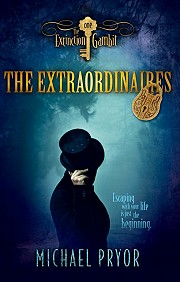
Of course there is my own Laws of Magic series, where rational, codified magic abounds in a world suspiciously like our own just before WW1. Conspiracies, intrigue, comedy and romance in a helter-skelter imbroglio. When this series ended with Hour of Need (2011) I was so bereft that I immediately threw myself into a new Steampunk series, the result of which was The Extinction Gambit, the first in The Extraordinaires series, which features sinister magic, the lost tribe of Neanderthals, a young man who may or may not be Mowgli and a spirited albino juggler and inventive genius, all set against the backdrop of the 1908 London Olympic Games.
Steampunk is full dash and style, mixed with a healthy sense of awe. It has vast variety and manifold pleasures waiting for your enjoyment. Break out your leather aviator's helmet, grab your white silk scarf and jump aboard!

September, 2014
Michael Pryor is a Melbourne-based author of adult and young adult fiction who is currently giving presentations on Steampunk for the National Trust.
Michael Pryor answers The Usual Questions
Talk to Michael Pryor on Facebook
See also in this series:
The Immortal Enduring Vampire by Rhiannon Frater
Get Ready Cyberfunkers: Black Science Fiction by K. Ceres Wright
Defining Horror by Jeani Rector
Steampunk: A Marvellous Excursion by Michael Pryor
Female Private Eyes in Fiction: From Lady Detectives to Hard-Boiled Dames by Colleen Collins
The Good, the Bad and the Ugly: Western Writing by Julia Robb
Grand Tradition Science Fiction: Stories that Want to Have Fun, by Bascomb JamesUnintended Invention: The Fantasy of Manners, by Ellen Kushner
For posts about Melbourne events, places, news, reviews, giveaways, see our Facebook Page:



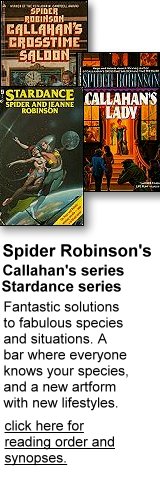
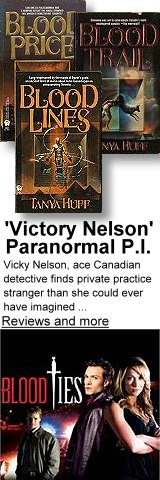
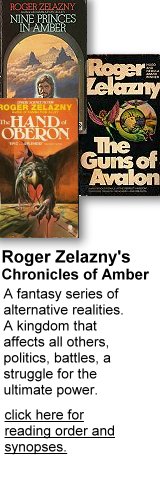



 Published in Melbourne, Victoria, Australia
Published in Melbourne, Victoria, Australia